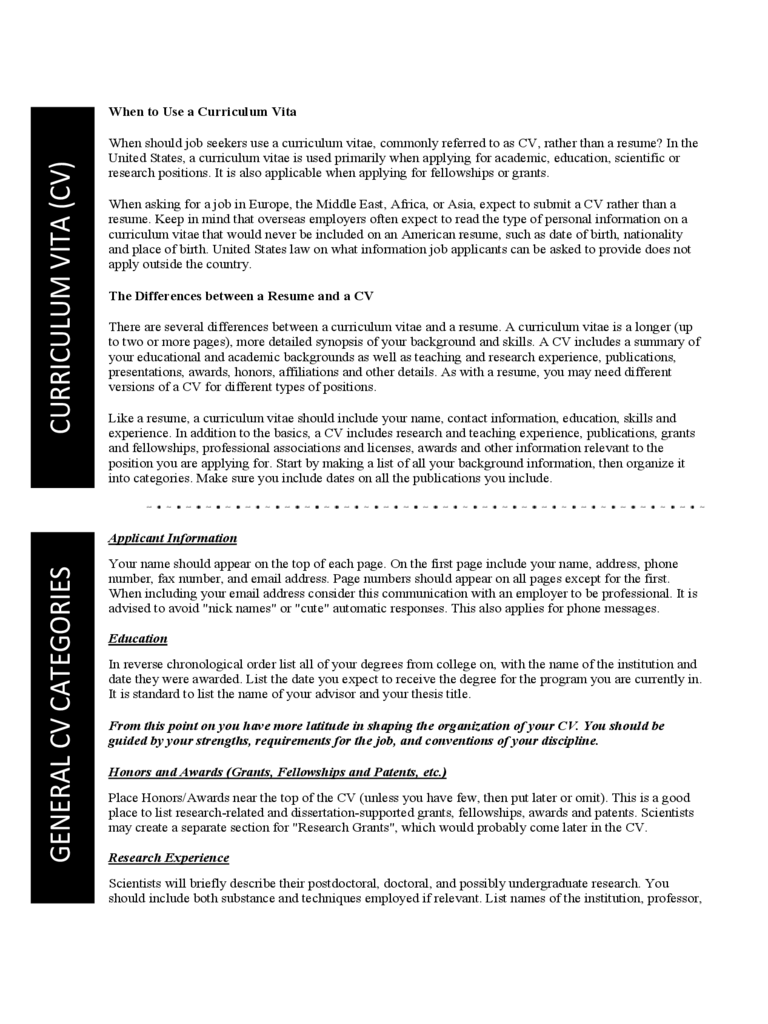Fillable Printable Curriculum Vita (CV) General CV Categories
Fillable Printable Curriculum Vita (CV) General CV Categories

Curriculum Vita (CV) General CV Categories

When to Use a Curriculum Vita
When should job seekers use a curriculum vitae, commonly referred to as CV, rather than a resume? In the
United States, a curriculum vitae is used primarily when applying for academic, education, scientific or
research positions. It is also applicable when applying for fellowships or grants.
When asking for a job in Europe, the Middle East, Africa, or Asia, expect to submit a CV rather than a
resume. Keep in mind that overseas employers often expect to read the type of personal information on a
curriculum vitae that would never be included on an American resume, such as date of birth, nationality
and place of birth. United States law on what information job applicants can be asked to provide does not
apply outside the country.
The Differences between a Resume and a CV
There are several differences between a curriculum vitae and a resume. A curriculum vitae is a longer (up
to two or more pages), more detailed synopsis of your background and skills. A CV includes a summary of
your educational and academic backgrounds as well as teaching and research experience, publications,
presentations, awards, honors, affiliations and other details. As with a resume, you may need different
versions of a CV for different types of positions.
Like a resume, a curriculum vitae should include your name, contact information, education, skills and
experience. In addition to the basics, a CV includes research and teaching experience, publications, grants
and fellowships, professional associations and licenses, awards and other information relevant to the
position you are applying for. Start by making a list of all your background information, then organize it
into categories. Make sure you include dates on all the publications you include.
Applicant Information
Your name should appear on the top of each page. On the first page include your name, address, phone
number, fax number, and email address. Page numbers should appear on all pages except for the first.
When including your email address consider this communication with an employer to be professional. It is
advised to avoid "nick names" or "cute" automatic responses. This also applies for phone messages.
Education
In reverse chronological order list all of your degrees from college on, with the name of the institution and
date they were awarded. List the date you expect to receive the degree for the program you are currently in.
It is standard to list the name of your advisor and your thesis title.
From this point on you have more latitude in shaping the organization of your CV. You should be
guided by your strengths, requirements for the job, and conventions of your discipline.
Honors and Awards (Grants, Fellowships and Patents, etc.)
Place Honors/Awards near the top of the CV (unless you have few, then put later or omit). This is a good
place to list research-related and dissertation-supported grants, fellowships, awards and patents. Scientists
may create a separate section for "Research Grants", which would probably come later in the CV.
Research Experience
Scientists will briefly describe their postdoctoral, doctoral, and possibly undergraduate research. You
should include both substance and techniques employed if relevant. List names of the institution, professor,
CURRICULUM VITA (CV) GENERAL CV CATEGORIES

project, and dates. Along with descriptions note any contribution you made (Some scientists append a
"Statement of Research Interests")
Teaching Experience
Where you place this section depends on the target institution (i.e. small teaching college) as well as your
strengths as a candidate. The basic information should include: Where, What, When you have taught and
your titles i.e. teaching fellow or lecturer.
Publications and Presentations
Where you place this section depends on the strength of your publication record. If substantial, it may come
first. If too lengthy or short it can come at the end of the CV or have an additional page. Some candidates
will subdivide this category into:
Publications (if have you enough, you can separate this into Books, Abstracts, Reviews, other
publications, etc...). Use standard bibliographic form for publications.
Papers and Presentations. Include dates/locations with titles of your presentations.
Avoid listing published abstracts in with papers. List Abstracts as a separate section. Otherwise, it gives
the impression of "padding."
Related Professional Experience
Use this category for any experience that is related to teaching, research, and administration, i.e. conference
organizing, tutoring, and committee work.
Languages
Accurately assess your knowledge level of a language: native, fluent, proficient or working knowledge.
Optional Sections
Memberships of Professional Organizations
Scholarly Associations
Travel or Study Abroad
References
Most academics tend to operate within small, informal networks; the names of references will convey
significant information to most readers. Most applicants will list their references at the end of their CV.
Include:
Full name
Title
Institutional address
Telephone address/email/fax
Three references are expected, but you may add more if their evaluations would add significant information
** make sure your references know they are listed and have a copy of your CV**
GENERAL CV CATEGORIES (cont.)



